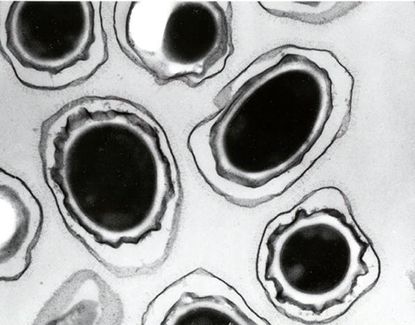Expert: Live anthrax may have been sent by military because spores were too tough to kill


Experts believe that there could be a simple explanation behind the Department of Defense inadvertently sending out live anthrax samples.
The spores are incredibly tiny and very tough, and the irradiation procedure used to deactivate them might not have killed each and every one, John Peterson, a microbiology professor who works with anthrax at the University of Texas Medical Branch, told NBC News. Anthrax spores are one micron in diameter, and samples could contain 10 billion spores, making it difficult for an X-ray or gamma ray to kill all the spores. "If a procedure kills 99.999 percent of the bacteria, there would still be 100,000 spores left viable," Peterson said. "They are very difficult to kill."
While anthrax is not fatal if treated in time, spores can be dispersed in the air and stay around for months or years, and it is considered a potential biological weapon. On Wednesday, the Pentagon confirmed samples of live anthrax were sent out to labs in nine states and an Air Force base in South Korea, and at least 26 people who came in contact with the samples are taking antibiotics as a precaution. Investigators say they are looking into the irradiation process that was used to inactivate the spores.
Subscribe to The Week
Escape your echo chamber. Get the facts behind the news, plus analysis from multiple perspectives.

Sign up for The Week's Free Newsletters
From our morning news briefing to a weekly Good News Newsletter, get the best of The Week delivered directly to your inbox.
From our morning news briefing to a weekly Good News Newsletter, get the best of The Week delivered directly to your inbox.
Create an account with the same email registered to your subscription to unlock access.
Sign up for Today's Best Articles in your inbox
A free daily email with the biggest news stories of the day – and the best features from TheWeek.com
Catherine Garcia is night editor for TheWeek.com. Her writing and reporting has appeared in Entertainment Weekly and EW.com, The New York Times, The Book of Jezebel, and other publications. A Southern California native, Catherine is a graduate of the University of Redlands and the Columbia University Graduate School of Journalism.
-
 'A direct, protracted war with Israel is not something Iran is equipped to fight'
'A direct, protracted war with Israel is not something Iran is equipped to fight'Instant Opinion Opinion, comment and editorials of the day
By Harold Maass, The Week US Published
-
 Today's political cartoons - April 17, 2024
Today's political cartoons - April 17, 2024Cartoons Wednesday's cartoons - political anxiety, jury sorting hat, and more
By The Week US Published
-
 Arid Gulf states hit with year's worth of rain
Arid Gulf states hit with year's worth of rainSpeed Read The historic flooding in Dubai is tied to climate change
By Peter Weber, The Week US Published
-
 Israel proposes two-month pause in Gaza war in exchange for all Hamas hostages
Israel proposes two-month pause in Gaza war in exchange for all Hamas hostagesSpeed Read Deal doesn't include an agreement to end war, but might be 'the only path that could lead to a ceasefire', said US officials
By Harriet Marsden, The Week UK Published
-
 Nato official warns of all-out war with Russia in next 20 years
Nato official warns of all-out war with Russia in next 20 yearsSpeed Read Civilians must prepare for life-changing conflict and mass mobilisation, says military chief
By Harriet Marsden, The Week UK Published
-
 Rishi Sunak visits Kyiv to announce £2.5 billion in military support for Ukraine
Rishi Sunak visits Kyiv to announce £2.5 billion in military support for UkraineSpeed Read Surprise trip comes amid increased Russian bombardment and escalation of Middle East crisis
By Harriet Marsden, The Week UK Published
-
 British warship repels 'largest Houthi attack to date' in the Red Sea
British warship repels 'largest Houthi attack to date' in the Red SeaSpeed read Western allies warn of military response to Iranian-backed Yemeni rebels if attacks on ships continue
By Richard Windsor, The Week UK Published
-
 Israel preparing to flood Hamas tunnels with seawater
Israel preparing to flood Hamas tunnels with seawaterSpeed Read IDF pumps could drive out terrorists but critics warn of danger to hostages and Gaza water supply
By Harriet Marsden, The Week UK Published
-
 Houthi rebels claim Red Sea ship attacks
Houthi rebels claim Red Sea ship attacksspeed read Iran-backed Yemeni group vows to escalate aggression towards Israel-linked vessels in revenge for Gaza war
By Harriet Marsden, The Week UK Published
-
 Israel plans next phase of Gaza war as first hostages released
Israel plans next phase of Gaza war as first hostages releasedSpeed read After four-day ceasefire 'we will not stop' until destruction of Hamas, says Israel
By Harriet Marsden, The Week UK Published
-
 Mob storms Russian airport 'looking for Jews'
Mob storms Russian airport 'looking for Jews'Speed Read Plane from Israel surrounded by rioters chanting antisemitic slogans after landing in Russia's Dagestan region
By The Week UK Published